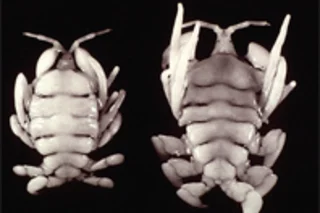For an epic story of whales and whaling, one need not turn to a 19th-century novel. Their travels and travails are coming to light through the genes of a parasite—the whale louse.
Three distinct populations of right whales roam the seas today: in the North Pacific, the North Atlantic, and the southern oceans. Their shared history was unclear until Jon Seger, an evolutionary geneticist, and his wife, whale biologist Victoria Rowntree, both at the University of Utah, took a look at the pea-size crustaceans called cyamids, or whale lice, that right whales carry by the thousands.
Seger, with an international team, sequenced the genes of each of the three species of cyamids that jump from whale to whale as the leviathans socialize. Reconstructing the whale-lice family tree, the researchers hoped, would shed light on the whales' social habits.
As it turns out, whales exchange lice so readily—and so thoroughly scramble ...















